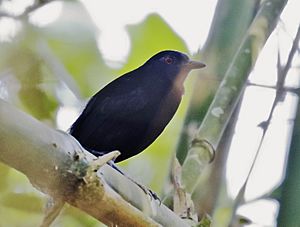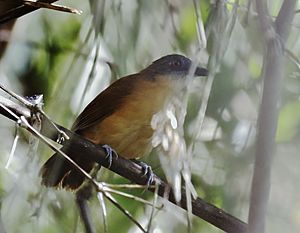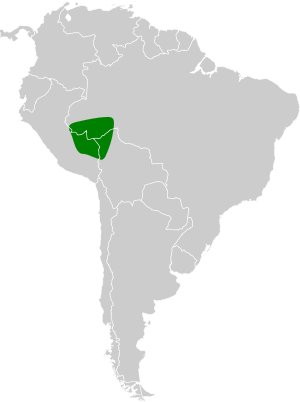Goeldi's antbird facts for kids
The Goeldi's antbird (scientific name: Akletos goeldii) is a small, fascinating bird. It belongs to a family of birds called Thamnophilidae, which are often found in the undergrowth of forests. This bird lives in the warm, wet forests of Bolivia, Brazil, and Peru.
Goeldi's antbird was once known by a different scientific name, Myrmeciza goeldii. However, after scientists studied bird families more closely, they decided to give it a new name, Akletos goeldii. This change helps to group birds that are more closely related together.
Quick facts for kids Goeldi's antbird |
|
|---|---|
 |
|
 |
|
| male above, female below | |
| Conservation status | |
| Scientific classification | |
| Genus: |
Akletos
|
| Species: |
goeldii
|
 |
|
| Synonyms | |
|
Myrmeciza goeldii |
|
Contents
Where Goeldi's Antbird Lives
Goeldi's antbird makes its home in specific types of forests. These are usually subtropical or tropical moist lowland forests. This means they live in areas that are warm all year round and get a lot of rain.
Forest Habitat Details
The bird prefers the lower parts of the forest. It often stays close to the ground, hidden among the plants. This helps it find food and stay safe from predators. These forests are rich in plant life, providing plenty of places to hide.
What Goeldi's Antbird Eats
Like other antbirds, Goeldi's antbird mainly eats insects. They are skilled at finding small bugs and other invertebrates. They forage, or search for food, among the leaves and branches.
Foraging Habits
These birds often follow swarms of army ants. As the ants march, they disturb insects and other small creatures. The antbirds then catch these fleeing creatures. This is a clever way for them to find a meal.
Appearance of Goeldi's Antbird
Goeldi's antbirds are small birds. The males and females look a bit different from each other. This is common in many bird species.
Male and Female Differences
The male Goeldi's antbird typically has darker feathers. The female often has a slightly different color pattern. These differences help them recognize each other. You can see pictures of both in the infobox above.
Conservation Status
The Goeldi's antbird is currently listed as "Least Concern" by the IUCN. This means that its population is stable. It is not considered to be in immediate danger of extinction.
Protecting Their Home
Even though they are not endangered, protecting their forest habitat is important. Forests provide homes for many different animals. Keeping these natural areas safe helps all the creatures that live there.
See also
 In Spanish: Hormiguero de Goeldi para niños
In Spanish: Hormiguero de Goeldi para niños


